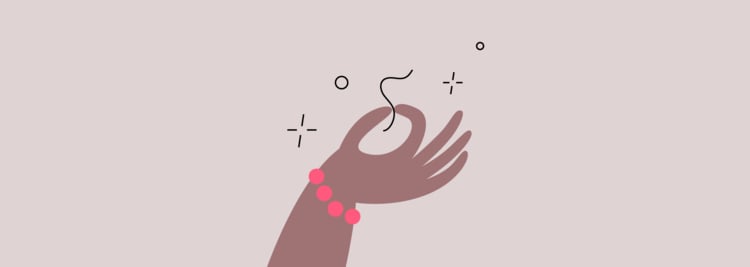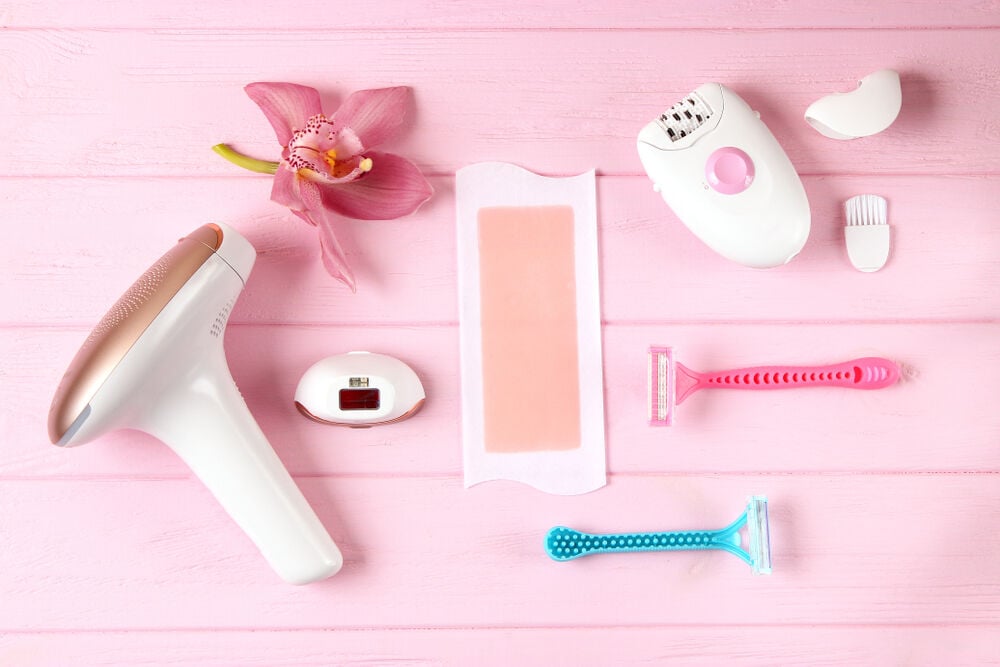Wondering if nipple hair is normal? Although it is possible for hair to grow in many places on the body, hair around the nipples can be bothersome for some people. You may not like the look of it, or you may find it embarrassing. Whatever the case may be, if you are wondering how to get rid of your nipple hair, we’ve got you covered.
-
Tracking cycle
-
Getting pregnant
-
Pregnancy
-
Help Center
-
Flo for Partners
-
Anonymous Mode
-
Flo app reviews
-
Flo Premium New
-
Secret Chats New
-
Symptom Checker New
-
Your cycle
-
Health 360°
-
Getting pregnant
-
Pregnancy
-
Being a mom
-
LGBTQ+
-
Quizzes
-
Ovulation calculator
-
hCG calculator
-
Pregnancy test calculator
-
Menstrual cycle calculator
-
Period calculator
-
Implantation calculator
-
Pregnancy weeks to months calculator
-
Pregnancy due date calculator
-
IVF and FET due date calculator
-
Due date calculator by ultrasound
-
Medical Affairs
-
Science & Research
-
Pass It On Project New
-
Privacy Portal
-
Press Center
-
Flo Accuracy
-
Careers
-
Contact Us
How to Get Rid of Nipple Hair


Every piece of content at Flo Health adheres to the highest editorial standards for language, style, and medical accuracy. To learn what we do to deliver the best health and lifestyle insights to you, check out our content review principles.
Is it okay to have nipple hair?
Nipples are one of many places on your body where hair follicles can be found. It is completely normal to have nipple hair. At the same time, having hair growing on your breasts may be a sign of something more serious, in which case it is important to speak with your doctor.
Although it is not known exactly how many women have nipple hair, having hair around the nipple is fairly common. It’s not considered a sign of any medical condition or reason for concern.
Hair color, length, and texture can all vary from person to person. Some people may find that they have coarse, dark nipple hair, while others will have fine, light-colored hair. The color and texture can depend on ethnicity, age, and hormonal balance. Even though in most cases hairy nipples are completely normal, they may be a source of embarrassment for some. There are various forms of hair removal such as plucking or shaving.
It’s important to tell your doctor or ob-gyn if you suddenly start finding hair on your breasts. If you aren’t going through a hormonal shift such as pregnancy or menopause, there may be a more serious underlying cause for hair on your nipples.
What causes female nipple hair?
Having hair around your nipples is a normal part of being human. Many people have it, and it’s usually no cause for concern. There are a few underlying conditions that can cause excessive hair on your nipples, though, and some of these can be serious.
Hormonal changes
As we age, our hormones go through changes. From puberty to pregnancy to menopause, shifting hormones can mean hair in places we haven’t seen it before, including the breasts. Women in their 20s or 30s can also go through hormonal changes, resulting in nipple hair.
Take a quiz
Find out what you can do with our Health Assistant
Hormone imbalances
In some women, hormone imbalances result in an overproduction of certain hormones, particularly testosterone. In addition to producing more hair in certain places, like the nipples, having high testosterone levels can also manifest in other ways, including:
- Hair on face and body
- Reduced breast size
- Balding
- Oily, acne-prone skin
- Irregular periods
- Mood changes
- Deep voice
Polycystic ovary syndrome
Polycystic ovary syndrome (PCOS) is an endocrine disorder that usually affects women of childbearing age. It is diagnosed if a woman has two of these three signs: excess androgen, irregular periods, and polycystic ovaries that are revealed in an ultrasound examination. PCOS can result in symptoms such as:
- Excessive male-pattern hair growth in places like the face and breasts, baldness, or acne (all of these are due to excess androgen)
- Irregular periods (prolonged menstrual cycles, abnormal uterine bleedings, or no periods at all)
- Infertility (usually due to anovulation)
- Mood disorders such as depression and anxiety
- Polycystic ovaries (multiple small follicles in ovaries)
Cushing’s syndrome
When the body is exposed to high levels of cortisol for extended periods of time, Cushing’s syndrome can develop. Having hair on your breasts is one of the symptoms of this syndrome. Others include:
- High blood pressure
- Purple stretch marks, called striae, located on the abdomen, breasts, thighs, and arms
- Weight gain around the midsection, upper back, and/or face
- Round or “moon” face
- Hair around the face that is thicker and darker than normal
- Acne-prone skin
- Irregular or absent periods
- Depression, anxiety, and/or mood swings
- Headaches
- Severe fatigue
- Bruising easily
Medications
Certain medications, such as glucocorticosteroids and testosterone, can cause nipple hair to grow. These medications can also result in additional symptoms related to excess testosterone and cortisol, such as Cushing’s syndrome.
Is it safe to remove nipple hair?
While removing nipple hair is generally considered safe, some methods, such as tweezing, waxing, or shaving, can be uncomfortable. In addition, these methods can also increase the chances of ingrown hairs or infection, both of which can be painful.
There is nothing dangerous about removing nipple hair. At the same time, if you decide to remove it at home, use common-sense precautions. Go carefully and slowly in order to avoid cutting or nicking your skin. You can also look into other options, such as electrolysis or laser hair removal, which are also considered safe. Even though they cost more than at-home methods, both are good choices for those seeking a longer-term solution to nipple hair. Avoid depilatory creams and bleach, both of which can cause unwanted side effects like skin irritation and rashes.
How to get rid of nipple hair

If your nipple hair is making you uncomfortable and you want to get rid of it, there are a number of ways to go about it. Shaving, tweezing, and laser hair removal are a few of the options. While most forms are safe, some do come with potential, albeit minor, risks.
- Trimming nipple hair with scissors is one of the simplest methods. Use small scissors, like the ones used to trim your nails. Work in good light and, moving slowly and carefully, hold your skin down with one hand while cutting the hair with the other. Keep scissors close to the skin, but avoid cutting your breast or nipple.
- Use tweezers. Though not the most comfortable option, tweezers can make fast work of nipple hair. Holding the skin firmly with your free hand, tweeze with the other. Because the hair surrounding your areola is very sensitive, it can help to tweeze after a hot shower, when the hair follicles are more open. Tweezing can also increase the chances of ingrown hairs or infection. If you decide to use this method, watch for signs of infection, such as discomfort, redness, or any discharge.
- Reach for the razor. Taking a shower is a convenient time to shave the hair around your nipples. As with tweezing, shaving can increase the chances of ingrown hairs or infection. And as with cutting the nipple hair with scissors, be very careful not to cut your sensitive skin with the razor.
- Get it waxed. Aestheticians trained in waxing and hair removal can safely remove nipple hair. Because waxing such a delicate area can be difficult, it is better to leave waxing to the professionals. Remember that waxing, like shaving or tweezing, can cause ingrown hairs or even an infection as hair regrows.
- Try electrolysis or laser hair removal. While these options cost more than at-home methods or waxing, they can also extend the length of time nipple hair takes to grow back or keep it away permanently. Electrolysis is generally less expensive than laser hair removal, though results may not be as long-lasting. When you go for an electrolysis session, the electrologist will insert an ultra-thin needle into the hair follicle and an electrical current will kill the hair root. In laser hair removal, a laser is used to deliver a low level of radiation to the hair follicles. While both can be mildly uncomfortable, they can result in fewer hairs and even permanent hair removal.
- Bring your hormones into balance. If hormone imbalance or high testosterone is causing hairy nipples, consider looking into hormone treatments. While birth control pills, which contain estrogen, may be a common option, explore other possibilities with your doctor, as any form of hormone therapy brings its own set of precautions and potential side effects.
While some people use a depilatory cream to remove unwanted hair on other parts of their body, using it around the nipples is not recommended. Both hair removal creams and bleach can contain harsh chemicals that can irritate sensitive areas, causing skin irritation and rashes. It’s better to avoid them and use one of the other, safer available options.
When to see a doctor
If you have hairy breasts but no other symptoms, there is no reason for concern. However, if you experience a sudden appearance of hair on your breasts, accompanied by additional symptoms, you should discuss these concerns with your doctor. Hair loss, mood disorders, irregular periods, or infertility can all point to an underlying imbalance or health concern, such as PCOS or Cushing’s syndrome. Your doctor can perform tests to help you determine the cause.
While you can remove nipple hair yourself, it can also be a good choice to speak with your doctor about the best possible method. Even though the choices for nipple hair removal are considered safe, side effects like ingrown hairs or infection can occur. Your doctor can help determine how best to avoid these uncomfortable and unwanted reactions.
Having hairy nipples is embarrassing for some people. Rest assured that you aren’t alone, and, as long as you aren’t experiencing other side effects, nipple hair is completely normal. However, if it makes you uncomfortable, you can choose from a number of hair removal options that are both safe and effective.


Hey, I'm Anique
I started using Flo app to track my period and ovulation because we wanted to have a baby.


The Flo app helped me learn about my body and spot ovulation signs during our conception journey.


I vividly
remember the day
that we switched
Flo into
Pregnancy Mode — it was
such a special
moment.
Real stories, real results
Learn how the Flo app became an amazing cheerleader for us on our conception journey.




